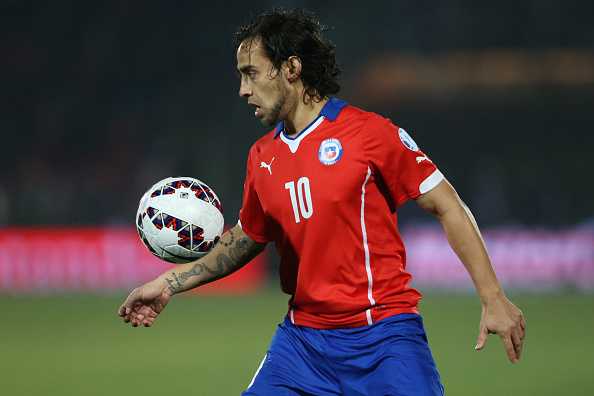
Keeghann Sinanan
The tournament hosts have seen off all comers so far en route to the final and it will be hard to peg them as underdogs on July 4
As Copa América 2015 has gone on, the more it has seemed like Chile's tournament to lose.
More from Goal.com : Transfer news | Copa's beautiful fans
On the pitch at least, La Roja have been the most consistent and entertaining team and have set a fine example as hosts with their standard of play.
Chile have picked up where they left off after their heralded World Cup 2014 showing, where they lost agonisingly to Brazil in the round of 16 on penalties.
A raucous fan base and a few players rounding into form at exactly the right time has helped the hosts to a final against Argentina, and we highlight five reasons why they can go one step further on July 4.
Eduardo Vargas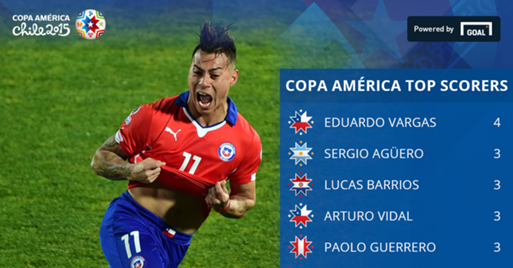 Uruguay had Luis Suárez in 2011. Brazil leaned on Robinho and Júlio Baptista in 2007, and rode Adriano’s Annus Mirabilis to glory in 2004.
Uruguay had Luis Suárez in 2011. Brazil leaned on Robinho and Júlio Baptista in 2007, and rode Adriano’s Annus Mirabilis to glory in 2004.
Every recent Copa winner has been blessed with one player who has risen to the occasion to decide games with vital goals.
Arturo Vidal was set to become that figure for Chile with three goals in as many group-stage games. But when the Juventus man’s prolific touch disappeared, Eduardo Vargas stepped up to the plate.
The Napoli forward was no slouch in the first phase, netting alongside Vidal against Ecuador and Mexico to help his side to first place in their section.
A tense quarter-final win against Uruguay was followed by Chile’s toughest test of the tournament, with Peru fighting them blow-for-blow, even with a man disadvantage after Carlos Zambrano’s dismissal.
Vargas had already bundled home an opportunistic finish to send his team into a half-time lead, only for Gary Medel’s own goal to restore parity.
However, with less than half-an-hour remaining, Vargas blew the roof off Estadio Nacional with a long-distance screamer that dipped over Pedro Gallese. Deflection or not, it was an effort that was destined for the net, a highlight-reel certainty.
His four goals make him the tournament’s top scorer with a game left. And heading into that one match, there will be no one on the pitch in Santiago bursting with more confidence.
Jorge Valdivia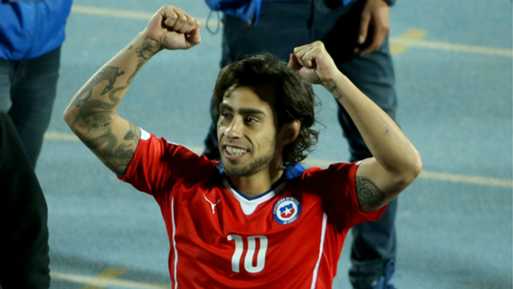 Vargas and Vidal may rightfully take the headlines with their goalscoring exploits for the hosts, but their most important attacking player has yet to hit the back of the net.
Vargas and Vidal may rightfully take the headlines with their goalscoring exploits for the hosts, but their most important attacking player has yet to hit the back of the net.
Jorge Valdivia is a perplexing figure at the best of times, a nailed-on caricature for the temperamental No.10, at times capable of making his team seem like they’re playing with 12 men or 10.
But when he’s on his game, surrounded by complementary players and trusted with the right responsibilities, he’s practically unstoppable. At Copa América 2015, there’s simply been no greater creative force.
He manufactures openings for himself and his team-mates, not just with the unbelievable frequency and accuracy of his through passes, but with his ability to manipulate his own momentum to fool defenders into conceding space or committing a foul. The perfect centrifuge for Chile’s horde of runners.
He ran the show against Mexico and followed that up with an evisceration of Bolivia, setting up two goals in La Roja’s 5-0 victory – the biggest of the tournament until Argentina demolished Paraguay in the semis.
However, his best performance came against Uruguay in the quarter-finals. Everything ran through him, as he created enough chances to threaten a repeat of the Bolivia scoreline by half-time.
Even when Chile began to taper off in the second-half, and at precisely the moment La Celeste started to believe, he made his defining contribution with the assist for Mauricio Isla’s late winner.
He followed that up with another accomplished playmaking display against Peru in the semi-finals and in this kind of form, no defence is safe. Chile at their greatest swarm the opposition from all angles, and Valdivia is the man calling the shots.
Santiago de Chile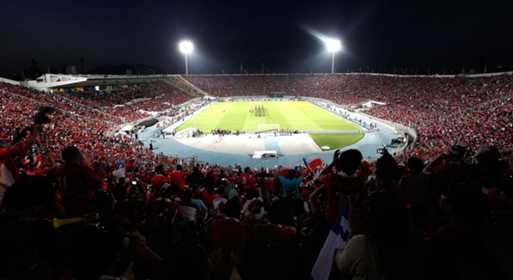 Home advantage was one of Chile’s biggest strengths heading into the tournament, and so far, the crowd has played their part in helping the hosts to advance.
Home advantage was one of Chile’s biggest strengths heading into the tournament, and so far, the crowd has played their part in helping the hosts to advance.
The mechanics of the draw and their results mean that Chile will play every one of their games at Estadio Nacional in Santiago. While fans in other cities may be a little disappointed not to see their team first-hand, the nation’s capital has become a hub for all things Roja.
Rumors of an initial disconnect between the players and fans and pollution concerns throughout the city itself were swept to one side as the intensity of the home crowds seemed to swallow opponents whole.
It’s an ideal marriage of fuel and flame, with Chile feeding off the energy of the crowd to sustain their furious style.
The noise inside the stadium has almost always been relentless and overwhelming – just like the team they support.
Ubiquitous style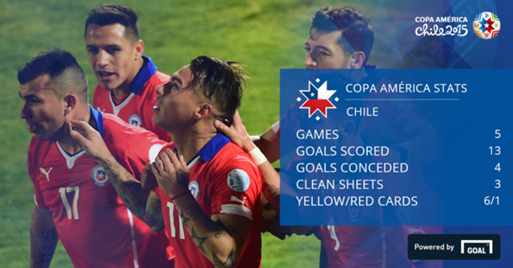 Under Jorge Sampaoli, Chile have developed one of the most recognisable styles of play on the planet.
Under Jorge Sampaoli, Chile have developed one of the most recognisable styles of play on the planet.
The Roja boss’ influence by predecessor Marcelo Biesla is well-documented, and though such an approach may not be sustainable through the marathon of a club season, it fares much better in the short burst of an international tournament.
Chile’s style is remarkable in the way it bends teams to their will. Rather than impose their own methods, opponents are forced to make containment their primary point of concern.
La Roja look for the quickest route to goal, with vertical passes, breakneck transitions and runners in waves guaranteeing end-to-end entertainment.
Their vigour has been seductive, with their 13 goals scored suprassing any other team’s tally, while everyone but Uruguay has conceded more than once against them.
Even La Celeste, who managed to hold them to a blank for 81 minutes, could scarcely believe their luck at half-time after surviving an onslaught on their goal by Valdivia and Co.
Opponents know exactly what they will get from La Roja, but stopping it is another matter entirely.
Are Argentina ready?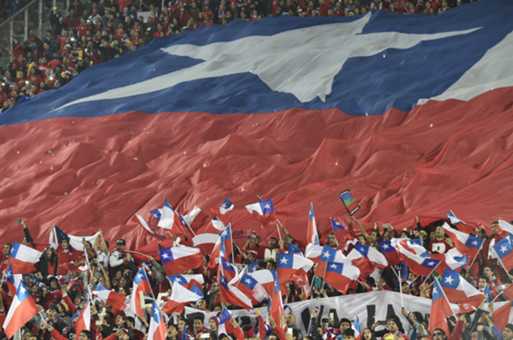 On paper at least, Chile were beneficiaries of favourable match-ups throughout the tournament.
On paper at least, Chile were beneficiaries of favourable match-ups throughout the tournament.
Group A provided little resistance in the end, with their only blip coming against a Mexico side that finished bottom of the pile after three games.
Moreover, the quarter-final draw placed Argentina, Colombia and Brazil on the opposite side of the bracket, meaning that La Roja would avoid three of the other favourites until the final.
However, it proved to be a moot point, with all three teams mostly playing well within themselves.
Gerardo Martino’s men will meet them in the final, but needed penalties to overcome Colombia in the last eight and, until the second Paraguay encounter, had not displayed the attacking verve that a roster of Lionel Messi, Sergio Agüero and Ángel Di María is capable of.
Argentina strutted their stuff in spectacular fashion with a 6-1 win over La Albirroja in the semis, but their previous four outings were significantly tighter affairs.
Chile have remained favourites by living up to expectations game after game, with no other team rising to their level. Every opponent they’ve faced has eventually collapsed against their unrelenting style.
Argentina may feel that they've finally released the shackles, but Chile have been unchained since long before the final.
More from Goal.com : Transfer news | Copa's beautiful fans
On the pitch at least, La Roja have been the most consistent and entertaining team and have set a fine example as hosts with their standard of play.
Chile have picked up where they left off after their heralded World Cup 2014 showing, where they lost agonisingly to Brazil in the round of 16 on penalties.
A raucous fan base and a few players rounding into form at exactly the right time has helped the hosts to a final against Argentina, and we highlight five reasons why they can go one step further on July 4.
Eduardo Vargas
 Uruguay had Luis Suárez in 2011. Brazil leaned on Robinho and Júlio Baptista in 2007, and rode Adriano’s Annus Mirabilis to glory in 2004.
Uruguay had Luis Suárez in 2011. Brazil leaned on Robinho and Júlio Baptista in 2007, and rode Adriano’s Annus Mirabilis to glory in 2004.Every recent Copa winner has been blessed with one player who has risen to the occasion to decide games with vital goals.
Arturo Vidal was set to become that figure for Chile with three goals in as many group-stage games. But when the Juventus man’s prolific touch disappeared, Eduardo Vargas stepped up to the plate.
The Napoli forward was no slouch in the first phase, netting alongside Vidal against Ecuador and Mexico to help his side to first place in their section.
A tense quarter-final win against Uruguay was followed by Chile’s toughest test of the tournament, with Peru fighting them blow-for-blow, even with a man disadvantage after Carlos Zambrano’s dismissal.
Vargas had already bundled home an opportunistic finish to send his team into a half-time lead, only for Gary Medel’s own goal to restore parity.
However, with less than half-an-hour remaining, Vargas blew the roof off Estadio Nacional with a long-distance screamer that dipped over Pedro Gallese. Deflection or not, it was an effort that was destined for the net, a highlight-reel certainty.
His four goals make him the tournament’s top scorer with a game left. And heading into that one match, there will be no one on the pitch in Santiago bursting with more confidence.
Jorge Valdivia
 Vargas and Vidal may rightfully take the headlines with their goalscoring exploits for the hosts, but their most important attacking player has yet to hit the back of the net.
Vargas and Vidal may rightfully take the headlines with their goalscoring exploits for the hosts, but their most important attacking player has yet to hit the back of the net.Jorge Valdivia is a perplexing figure at the best of times, a nailed-on caricature for the temperamental No.10, at times capable of making his team seem like they’re playing with 12 men or 10.
But when he’s on his game, surrounded by complementary players and trusted with the right responsibilities, he’s practically unstoppable. At Copa América 2015, there’s simply been no greater creative force.
He manufactures openings for himself and his team-mates, not just with the unbelievable frequency and accuracy of his through passes, but with his ability to manipulate his own momentum to fool defenders into conceding space or committing a foul. The perfect centrifuge for Chile’s horde of runners.
He ran the show against Mexico and followed that up with an evisceration of Bolivia, setting up two goals in La Roja’s 5-0 victory – the biggest of the tournament until Argentina demolished Paraguay in the semis.
However, his best performance came against Uruguay in the quarter-finals. Everything ran through him, as he created enough chances to threaten a repeat of the Bolivia scoreline by half-time.
Even when Chile began to taper off in the second-half, and at precisely the moment La Celeste started to believe, he made his defining contribution with the assist for Mauricio Isla’s late winner.
He followed that up with another accomplished playmaking display against Peru in the semi-finals and in this kind of form, no defence is safe. Chile at their greatest swarm the opposition from all angles, and Valdivia is the man calling the shots.
Santiago de Chile
 Home advantage was one of Chile’s biggest strengths heading into the tournament, and so far, the crowd has played their part in helping the hosts to advance.
Home advantage was one of Chile’s biggest strengths heading into the tournament, and so far, the crowd has played their part in helping the hosts to advance.The mechanics of the draw and their results mean that Chile will play every one of their games at Estadio Nacional in Santiago. While fans in other cities may be a little disappointed not to see their team first-hand, the nation’s capital has become a hub for all things Roja.
Rumors of an initial disconnect between the players and fans and pollution concerns throughout the city itself were swept to one side as the intensity of the home crowds seemed to swallow opponents whole.
It’s an ideal marriage of fuel and flame, with Chile feeding off the energy of the crowd to sustain their furious style.
The noise inside the stadium has almost always been relentless and overwhelming – just like the team they support.
Ubiquitous style
 Under Jorge Sampaoli, Chile have developed one of the most recognisable styles of play on the planet.
Under Jorge Sampaoli, Chile have developed one of the most recognisable styles of play on the planet.The Roja boss’ influence by predecessor Marcelo Biesla is well-documented, and though such an approach may not be sustainable through the marathon of a club season, it fares much better in the short burst of an international tournament.
Chile’s style is remarkable in the way it bends teams to their will. Rather than impose their own methods, opponents are forced to make containment their primary point of concern.
La Roja look for the quickest route to goal, with vertical passes, breakneck transitions and runners in waves guaranteeing end-to-end entertainment.
Their vigour has been seductive, with their 13 goals scored suprassing any other team’s tally, while everyone but Uruguay has conceded more than once against them.
Even La Celeste, who managed to hold them to a blank for 81 minutes, could scarcely believe their luck at half-time after surviving an onslaught on their goal by Valdivia and Co.
Opponents know exactly what they will get from La Roja, but stopping it is another matter entirely.
Are Argentina ready?
 On paper at least, Chile were beneficiaries of favourable match-ups throughout the tournament.
On paper at least, Chile were beneficiaries of favourable match-ups throughout the tournament.Group A provided little resistance in the end, with their only blip coming against a Mexico side that finished bottom of the pile after three games.
Moreover, the quarter-final draw placed Argentina, Colombia and Brazil on the opposite side of the bracket, meaning that La Roja would avoid three of the other favourites until the final.
However, it proved to be a moot point, with all three teams mostly playing well within themselves.
Gerardo Martino’s men will meet them in the final, but needed penalties to overcome Colombia in the last eight and, until the second Paraguay encounter, had not displayed the attacking verve that a roster of Lionel Messi, Sergio Agüero and Ángel Di María is capable of.
Argentina strutted their stuff in spectacular fashion with a 6-1 win over La Albirroja in the semis, but their previous four outings were significantly tighter affairs.
Chile have remained favourites by living up to expectations game after game, with no other team rising to their level. Every opponent they’ve faced has eventually collapsed against their unrelenting style.
Argentina may feel that they've finally released the shackles, but Chile have been unchained since long before the final.






No comments:
Post a Comment